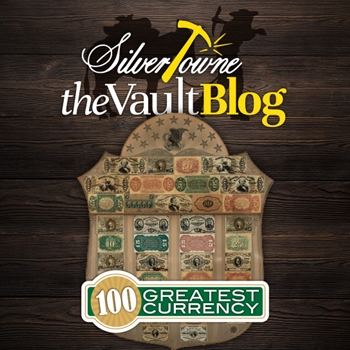
This go ‘round’s feature over one of the top 100 picks from Whitman Publishing’s 100 Greatest American Currency Notes publication is a little different than the rest. While not a currency note itself, it has made its way near the top after the survey taken revealing such a compilation showcased its results. A favorite among collectors and numismatists, authors Q. David Bowers and David M. Sundman will help us navigate this unique selection.
#14 - The Ultimate Treasury-Issued Display Item Fractional Currency Shield
Created by the Treasury Department in the late 1860s, the famous Fractional Currency Shield was intended for display but has since become a popular collector specimen. Intended for use by National Banks to help compare counterfeit currency with genuine notes, their attraction was apparent from the very get-go. The outline of the shield is printed in black as an eagle and stars appear at the top. The eagle is the same one found on the “Jackass Note,” which has already been covered in this series. Long story short, the eagle appears to resemble the head of a donkey when turned upside down. Few shields were printed in red or green but those are rare.
The shield itself consists of 39 specimens of fractional currency pasted by hand, 20 faces and 19 backs. All of the issues are first, second, and third issues with the shields having been made after the 15c Grant and Sherman notes in 1866. The display shield was mounted under glass in a wooden frame and sold for just $4.50 beginning in 1867. In 1869, the United States Treasurer stated that the remaining examples had been destroyed in Washington. Some of the shields after 1869 were featured with later fractional currency notes and sometimes with a postage stamp in the border. These were added after distribution.
No one really knows how many of the original shields were released. According to authors Bowers and Sundman, it is estimated that there have been anywhere between hundreds to 4,500.
Historic market value is an estimated $350 in 1960 for a Nice Very Fine condition. In 2005, it climbed to $7,000.







